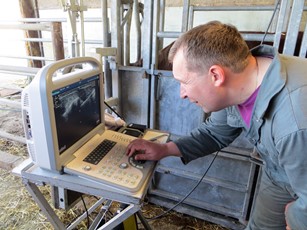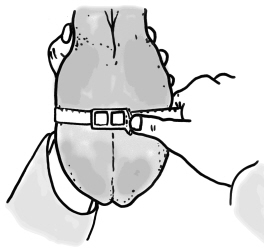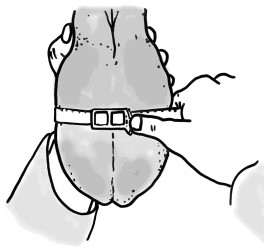Recording protocols

How Do I Submit Data?
Once a herd has been set up on the Signet database, clients can generate stationery (such as breeding records and weighsheets) directly from the Signet website.
They then have a choice to either:
- Enter data online - see video clips for more information
- Provide data in electronic files - file specification available here
Supplying Data Electronically
Signet clients can supply data to Signet in an electronic format.
All clients must supply data in exactly the same format – using identities for the sires and dams of their calves which exactly match the identities of these animals held on SignetData.com.
If you are using Farm or Herd Management Software to store your records, then it may be worth speaking to your software provider about the facility to export data to Signet. The file specification for supplying new animals records can be provided on request. For more information see our file specifications.
Weight Recording and Management Groups
Beefbreeder recording requires all heifers, steers and bulls to be weighed every 100 days from birth to 600 days of age. Information is analysed on a “contemporary group basis”, comparing animals reared under the same management to identify differences in genetic potential. Where a contemporary group contains fewer than 5 records it may be merged with other groups within the herd, dependant on the spread of ages within these groups.
Management Codes
The following codes are used to describe the current management of youngstock.
All sexes up to weaning (From 14 to 369 days of age):
221 = suckling dam only
222 = suckling dam and creep feed
223 = suckling nurse cow and creep
224 = suckling nurse cow only
225 = bucket fed
226= double suckling with creep
Bulls (370 days of age or more)
441 = commercial management
442 = standard pedigree management
443 = show management
Steers (370 days of age or more)
461 = commercial management
462 = standard pedigree management
Heifers (370 days of age or more)
451 = commercial management
452 = standard pedigree management
453 = show management
Calculating Adjusted Weights for Cattle
Signet's Beefbreeder analysis uses adjusted weights to compare growth rates, with recorded weights adjusted for age (100, 200, 300, 400 and 500 days) using within-animal linear regression.
There must be at least two weights entered on the database to get an adjusted weight, including the birth weight (or a standard birth weight, if no actual weight exists).In calculating an adjusted weight all of the weights for each animal are used from 0 days of age to 100 days after the target age. However, the adjusted weight is calculated only if one of these weights is within 30 days before or 100 days after the target age.
These are the windows for achieving an adjusted weight.
|
Target age (days) |
Weights used if taken between this number of days |
One weight must be taken between these ages |
|
100 |
0-200 |
70 – 200 days of age |
|
200 |
0-300 |
170 – 300 days |
|
300 |
0-400 |
270 – 400 days |
|
400 |
0-500 |
370 – 500 days |
|
500 |
0-600 |
470 - 600 days |
Weights over 600 days of age have no effect on adjusted weights.
Getting the Best Out of Performance Recording
The quality of the Estimated Breeding Values (EBVs) produced for your herd are only as good as the data that has contributed to them. Some herds put themselves at a disadvantage by not providing sufficient high quality data to reveal the quality of their cattle within the analysis.
By following the points outlined below, not only will you increase the accuracy of your EBVs – but you are also more likely to see the figures for genetically superior cattle within your herd increase.
When submitting calving records:
- Submit clear, accurate and timely data
- Where possible provide ET recipient, fostering and birth weight records
- Check data coming back before the main analysis.
When submitting weights:
- Try to treat all your cattle the same – where different management groups exist code them clearly
- Check your weighscales (weigh yourself as a test)
- Weigh cattle as close to the recommended dates as possible
- Weigh them all, with the odd exception of any calves in very poor health.
Collecting the Best Ultrasound Scanning Data
 When ultrasound scanning your cattle:
When ultrasound scanning your cattle:- Get your appointment booked in good time
- Scan at an appropriate age, ensuring calves are at least 300 and not more than 500 days of age
- Try to treat all your calves the same or ask the technician to subdivide them into different management groups (a show team, commercial team etc)
- Don’t just scan the best or the males – it won’t lead to higher EBVs
- Large contemporary groups are advantageous.
To make the ultrasound scanning day run smoothly remember:
- Cattle are weighed on the day, so a weigh crate is required
- The handling must take place undercover, preferably in a building without direct sunlight so the scans can be easily seen
- Mains power is necessary at the scanning point. Generators can only be used if fitted with a voltage regulator and surge protector
- A table is required for the scanning equipment
- Handling facilities must be adequate and ensure adequate help is available to handle cattle safely
- Please have your records to hand in case there are any queries relating to the identification of the animal being scanned.
Making Recording Easy
Most of the records required for herd recording are already collected for registration and/or management purposes. It really is just a case of making the information available to us. However, some steps can be taken to simplify the process:
- Collect records around other tasks.
There is no need to make a special job of weighings if they can be made to coincide with a time when cattle are being handled for another purpose. Many herds weigh at weaning, housing and spring turnout, which can cover three of the ideal four weighings in the year. - Recording birth weights is not essential.
Although having the data is important, where systems are extensive or there are potential difficulties with aggressive cows, the evaluation will work without it. Without an actual measurement, a Birth Weight EBV would still be predicted using its known correlations with the other traits that are measured e.g. growth rate, calving ease, gestation length etc. However, where this occurs, the accuracy of the EBV will be lower than if the trait had been measured. - Only collect additional data when there is sufficient need.
In particular, it is recommended that scanning should only be carried out when there are at least five animals in the management group (or ‘contemporary group’). Too few animals in a group means an insufficient number is available for comparison purposes which limits the value of the data in the evaluation. - Consider the use of labour saving devices.
In particular, in larger herds, consider using devices such as electronic tags and weigh scales. - Involve your staff.
Breeding decisions and the associated work is often carried out partly or wholly by farm staff. Whoever is involved in collecting the records needs to be aware of the importance of accuracy and timeliness and ideally be made party to the results of their efforts.
Additional Beef Measurements
Cow Mature Size and Body Condition Score
Breeders wishing to record the mature size of their cows can now record these weights on an annual basis at weaning time.When weights are submitted breeders are also asked to record body condition score (1 to 5) and a management code; either commercial management or standard pedigree management.This trait may be of particular importance for maternal breeds, where it may be desirable to limit increases in cow mature size, whilst continuing to improve calf growth rates.
Udder and Teat Scores
Breeders wishing to record udder and teat conformation can score their cows on an annual basis at calving time using a 3-point scale and submit data on the following form. EBVs for these traits will be produced once sufficient amounts of data have been collected.

Recording Scrotal Circumference

 It is well-known that bulls with above average scrotal circumference will produce female offspring that reach puberty sooner and have the potential for greater lifetime reproductive performance.
It is well-known that bulls with above average scrotal circumference will produce female offspring that reach puberty sooner and have the potential for greater lifetime reproductive performance.
Beefbreeder members recording with Signet can now include scrotal circumference measurements within their recording program and once a sufficient number of records have been submitted, EBVs will be produced for this trait.
Breeders wishing to submit scrotal circumference measurements should wait until bulls are 400 days of age and then record a scrotal circumference measurement on their weighsheets. Measurements should be in centimetres and taken across the widest point of the scrotum (see diagram).
Collection of this data is entirely at the discretion of individual breeders. If measurements are being collected breeders are advised to use a crush and take care to avoid the potential risk of injury.
Docility
Docility Scores (Record animals once between the ages of 350 and 500 days only)
- Docile: Settled, somewhat dull, does not pull against headgate, exits crush calmly
- Restless: Slightly restless, stubborn during handling, may try to back out of crush, pulls back on
headgate, some flicking of tail, exits crush promptly - Nervous: Nervous and impatient, a moderate amount of struggling, movement and tail flicking,
repeated pushing and pulling on headgate, exits crush briskly - Flighty (Wild): Jumpy and out of control, quivers and struggles violently, may bellow and froth at
mouth, continuous tail flicking, defecates and urinates during handling - Aggresive: May be similar to Score 4 but with added aggressive behaviour, fearful extreme
agitation, continuous movement which may include jumping and bellowing while in crush, exits crush
frantically and may try to attack through crush